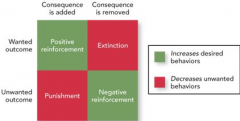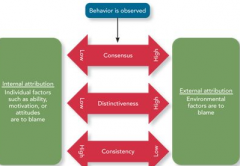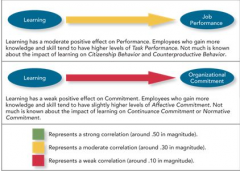![]()
![]()
![]()
Use LEFT and RIGHT arrow keys to navigate between flashcards;
Use UP and DOWN arrow keys to flip the card;
H to show hint;
A reads text to speech;
58 Cards in this Set
- Front
- Back
|
Learning
|
A relatively permanent change in an employee's knowledge or skill that results from experience. See also Knowledge
|
|
|
Decision making
|
The process of generating and choosing from a set of alternatives to solve a problem.
|
|
|
Expertise
|
The knowledge and skills that distinguish experts from novices, 239
|
|
|
Explicit knowledge
|
Knowledge that is easily communicated and available to everyone, 239, 240
|
|
|
Tacit knowledge
|
Knowledge that employees can only learn through experience, 239–240, 257
|
|
|
Contingencies of reinforcement
|
Four specific consequences used by organizations to modify employee behavior, 241
|
|
|
Positive reinforcement
|
When a positive outcome follows a desired behavior, 241, 242
|
|
|
Negative reinforcement
|
An unwanted outcome is removed following a desired behavior, 241
|
|
|
Punishment
|
When an unwanted outcome follows an unwanted behavior, 241
|
|
|
Extinction
|
The removal of a positive outcome following an unwanted behavior, 241
|
|
|
Schedules of reinforcement
|
The timing of when contingencies are applied or removed, 242–243
|
|
|
Continuous reinforcement
|
A specific consequence follows each and every occurrence of a certain behavior, 242
|
|
|
Fixed interval schedule
|
Reinforcement occurs at fixed time periods, 242
|
|
|
Variable interval schedule
|
Reinforcement occurs at random periods of time, 242–243
|
|
|
Fixed ratio schedule
|
Reinforcement occurs following a fixed number of desired behaviors, 243
|
|
|
Variable ratio schedule
|
Behaviors are reinforced after a varying number of them have been exhibited, 243
|
|
|
Social learning theory
|
Theory that argues that people in organizations learn by observing others, 243
|
|
|
Behavioral modeling
|
When employees observe the actions of others, learn from what they observe, and then repeat the observed behavior, 243–245
|
|
|
Learning orientation
|
A predisposition or attitude according to which building competence is deemed more important by an employee than demonstrating competence, 246
|
|
|
Performance-prove orientation
|
A predisposition or attitude by which employees focus on demonstrating their competence so that others think favorably of them, 246
|
|
|
Performance-avoid orientation
|
A predisposition or attitude by which employees focus on demonstrating their competence so that others will not think poorly of them, 246
|
|
|
Programmed decisions
|
Decisions that are somewhat automatic because the decision maker's knowledge allows him or her to recognize the situation and the course of action to be taken, 246
|
|
|
Intuition
|
An emotional judgment based on quick, unconscious, gut feelings, 248–249
|
|
|
Crisis situation
|
A change—sudden or evolving—that results in an urgent problem that must be addressed immediately, 249
|
|
|
Nonprogrammed decisions
|
Decisions made by employees when a problem is new, complex, or not recognized, 248, 249
|
|
|
Rational decision-making model
|
A step-by-step approach to making decisions that is designed to maximize outcomes by examining all available alternatives, 249–250
|
|
|
Bounded rationality
|
The notion that people do not have the ability or resources to process all available information and alternatives when making a decision, 250
|
|
|
Satisficing
|
When a decision maker chooses the first acceptable alternative considered, 250
|
|
|
Selective perception
|
The tendency for people to see their environment only as it affects them and as it is consistent with their expectations, 252
|
|
|
Projection bias
|
The faulty perception by decision makers that others think, feel, and act the same way as they do, 252
|
|
|
Social identity theory
|
A theory that people identify themselves based on the various groups to which they belong and judge others based on the groups they associate with, 252
|
|
|
Stereotypes
|
Assumptions made about others based on their social group membership, 252
|
|
|
Heuristics
|
Simple and efficient rules of thumb that allow one to make decisions more easily, 252
|
|
|
Availability bias
|
The tendency for people to base their judgments on information that is easier to recall, 252
|
|
|
Fundamental attribution error
|
The tendency for people to judge others' behaviors as being due to internal factors such as ability, motivation, or attitudes, 254
|
|
|
Self-serving bias
|
When one attributes one's own failures to external factors and success to internal factors, 254
|
|
|
Consensus
|
Used by decision makers to attribute cause; whether other individuals behave the same way under similar circumstances, 254
Did others act the same way under similar situations? In other words, did others arrive late on the same day? |
|
|
Distinctiveness
|
Used by decision makers to attribute cause; whether the person being judged acts in a similar fashion under different circumstances, 254
Does this person tend to act differently in other circumstances? In other words, is Joe responsible when it comes to personal appointments, not just work appointments? |
|
|
Consistency
|
Used by decision makers to attribute cause; whether this individual has behaved this way before under similar circumstances, 254
Does this person always do this when performing this task? In other words, has Joe arrived late for work before? |
|
|
Escalation of commitment
|
A common decision-making error in which the decision maker continues to follow a failing course of action, 255–256
They may feel an obligation to stick with their decision to avoid looking incompetent. They may also want to avoid admitting that they made a mistake. |
|
|
Training
|
A systematic effort by organizations to facilitate the learning of job-related knowledge and behavior.
|
|
|
Knowledge transfer
|
The exchange of knowledge between employees, 258–259
|
|
|
Behavior modeling training
|
A formalized method of training in which employees observe and learn from employees with significant amounts of tacit knowledge, 258
|
|
|
Communities of practice
|
Groups of employees who learn from one another through collaboration over an extended period of time, 259
|
|
|
Transfer of training
|
Occurs when employees retain and demonstrate the knowledge, skills, and behaviors required for their job after training ends, 259
|
|
|
Climate for transfer
|
An organizational environment that supports the use of new skills, 259
|
|
|
characteristic of explicit and tacit knowledge
|

|
|
|
operant conditioning components
|

|
|
|
Contingencies of Reinforcement
|

|
|
|
Schedules of reinforcement
|

|
|
|
The Modeling Process
|

|
|
|
Rational decision making vs bounded rationality
|

|
|
|
Consensus, Distinctiveness, and Consistency
|

|
|
|
Effects of Learning on Performance and Commitment
|

|
|
|
Internal attribution
-individual factors such as ability, motivation, or attitudes are to blame |
Low consensus ( general agreement amongst people)
low Distinctiveness High consistency |
|
|
External attribution
-environmental factores are to blame |
High consensus ( general agreement amongst people)
High Distinctiveness Low consistency |
|
|
How does learning effect job performance?
|
learning has a moderate positive effect on job permanence. employees who gain more knowledge and skills tent to have higher levels of task performance
|
|
|
How does learning effect organization commitment?
|
learning has a weak positive effect on commitment. employees who gain more knowledge and skills tend to have slightly higher level of affective commitment.
|

